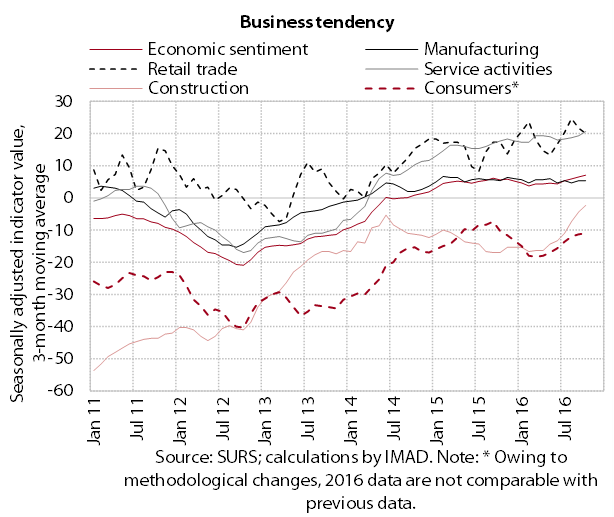Competitiveness
Related Files:
Slovenian Economic Mirror 8/2016
Economic activity in Slovenia continues to strengthen as a result of exports and household consumption. The labour market is recovering faster than last year. After almost two years of decline, consumer prices have been higher year on year in the last six months. The volume of loans to domestic non-banking sectors continues to contract year on year. The general government deficit on a cash basis dropped almost by half year on year in the first nine months.
Related Files:
- International environment
- Economic developments
- Labour market
- Prices
- Balance of payments
- Financial markets
- Public finance

Moderate economic growth in the euro area continues. In the third quarter, GDP also rose by 0.3% quarter on quarter and 1.7% year on year (seasonally adjusted). Economic growth was recorded for all Slovenia's main trading partners from the euro area, which was mainly in line with the EC’s expectations. It was mainly driven by growth in private consumption. Economic sentiment and consumer confidence also indicate similar growth for the last quarter of the year.

International institutions left their forecasts for the economic growth of Slovenia’s main trading partners more or less unchanged in the autumn, but took the view that downside risks to growth had increased. Economic growth is expected to hover between 1.5% and 1.7% this year and in 2017 and 2018. With labour market conditions improving further, this will continue to be driven by growth in private consumption. Of Slovenia's main trading partners outside the euro area, the forecasts indicate favourable GDP growth in Croatia, which will be fuelled by domestic demand. Russia has not yet emerged from recession this year, but its economic situation is predicted to improve next year, particularly as a result of increases in the price of oil. The risks to the forecast have heightened, primarily as a result of political uncertainty, subdued GDP growth outside the EU and weak global trade.
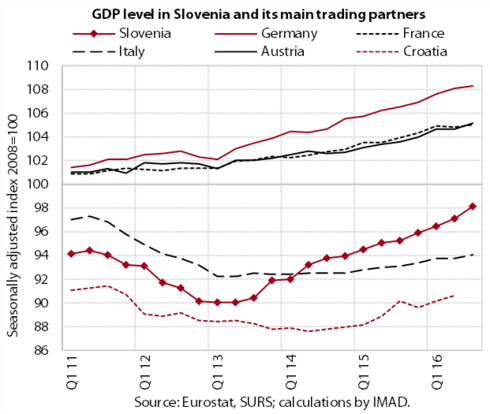
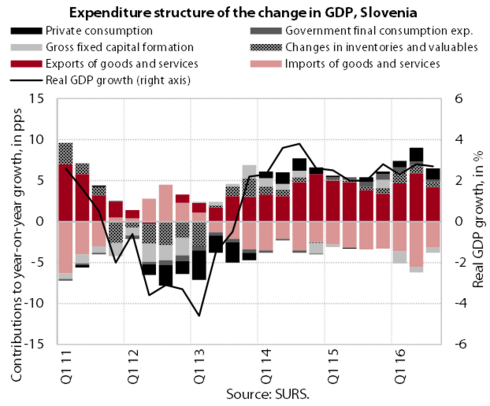
Growth in economic activity continued in the third quarter; in the first three quarters of the year, GDP was up 2.6% year on year in real terms. Relative to the previous quarter, GDP increased by 1.0% (seasonally adjusted), which was the highest growth rate in the last nine quarters and significantly higher than the euro area average. Foreign demand and the improving competitive position of Slovenian companies on foreign markets continue to strengthen exports, which remain one of the main drivers of economic growth. Closely linked to exports, the growth of manufacturing output is among the fastest in the EU this year, having exceeded the pre-crisis level in the summer months. The situation is also improving for the majority of service activities, particularly tourism-related segments, which recorded significant increases in arrivals and spending by foreign tourists. Reflecting the favourable economic situation, labour market conditions continue to improve, which is raising consumer confidence and encouraging households to spend. The recovery in private consumption is therefore more pronounced this year and managed to catch up with year-on-year GDP growth in the first three quarters of the year. In addition to the consumption of durable goods, which has already been rising for several years and represents one-tenth of total consumption, spending on other goods and services also rose in the third quarter. Less favourable developments have been recorded only for total investment, which is lower than last year as a result of the reduced public investment owing to the standstill in the absorption of EU funds upon the transition to the new financial perspective. Private investment continues to strengthen, which is related to higher capacity utilisation, strong business results, the deleveraging of companies and more favourable lending conditions. Given that bank lending to the corporate sector remains modest, we estimate that companies are now using their own resources to finance investment to a greater extent than in the past. Despite the relatively faster narrowing of the gap in recent years, Slovenia remains in the group of euro area countries whose GDP levels lag the most behind pre-crisis figures.

Real merchandise exports and imports increased further in the third quarter, seasonally adjusted. We estimate that the growth of exports continued in most sectors. The most significant contribution to growth was generated by the motor vehicle manufacturing sector, which accounts for 16% of Slovenia's total merchandise exports. The growth of merchandise imports was based on the strengthening of private business investment and higher household consumption.

After declining in the second quarter, real exports of services bounced back in the third quarter; however, the growth of real imports of services remained moderate (seasonally adjusted). The growth in exports largely reflects higher spending by foreign tourists in Slovenia and increased exports of transport services. Import growth is underpinned particularly by increased domestic household spending abroad (tourism) and higher imports of technical business services related to trade.

The growth of production volume in manufacturing is broad-based. Manufacturing output increased in the third quarter in all industry groups according to technology intensity. This figure was also up year on year in most industries for the first nine months of the year. The weakest growth was still recorded by low-technology industries, where the production of some of the more labour-intensive industries (the textile and furniture industries) also started to rebound this year. In addition to revenue growth on foreign markets, with the recovery in domestic demand most industries also recorded higher sales revenues on the domestic market.

The value of construction output remained roughly unchanged in the third quarter. Construction activity has been much lower this year than in 2015, which is mostly attributable to the reduced government investment upon the transition to the new EU financial perspective. In the wake of extremely low levels of activity during the crisis, the construction of flats is on the rise amid the improving labour market conditions. Activity in the construction of non-residential buildings has also increased recently.

Distributive trades recorded further growth in the sales of durable and semi-durable goods in the third quarter, which was mainly the result of increased household consumption. The sales of computer, sport, household and telecommunication equipment, furniture and passenger cars to natural persons rose in particular. Turnover in the sale of food products remained at the lowest level since 2008, reflecting changes in consumer buying behaviour, which were also partly due to the crisis; this was the only sector to see no year-on-year growth in the first nine months of 2016. The highest year-on-year turnover growth in this period (by over one-fifth) was recorded in the sale of motor vehicles, as a result of stronger sales abroad and further growth in the sales of new passenger and goods motor vehicles to domestic buyers.

The growth of nominal turnover in market services continues and remains broad-based. In the first nine months, turnover was up year on year in most market services. This growth was largely driven by foreign demand and private consumption (transportation; accommodation and food service activities; computer services). Less favourable results were recorded for segments that are more dependent on domestic investment demand (architectural and technical services).

Reflecting the broad-based economic growth, the number of employed persons increased more than last year. The year-on-year rise in the number of employed person was stronger in the first nine months of 2016 than for the same period in 2015, particularly in manufacturing, professional, scientific and technical activities, and accommodation and food service activities. With the relaxation of hiring restrictions, public service activities recorded higher employment growth in the health sector, public administration and primary education. Companies’ expectations about future employment are at the highest level since the onset of the crisis.

Amid higher levels of recruitment, the number of registered unemployed persons continues to decline. This decline is attributable not only to the outflow into employment, which was also up year on year in the first eleven months, but also to the decreasing inflow into unemployment, particularly owing to the termination of fixed-term contracts. There were also fewer first-time jobseekers, which in our view was also partly due to the slightly smaller generations of young people finishing school and improved job prospects when leaving school to enter the labour market. At the end of November, a total of 96,843 persons were registered as unemployed, which is 9.8% less than last year.

Average gross earnings increased again in the third quarter; their growth remains significantly higher than for the same period of the previous year. The stronger growth recorded in the private sector is linked to the strengthening of economic activity; in the public sector, this is attributable to the partial relaxation of austerity measures for public servants (promotions and the return of the pay scale). In contrast to previous years, earnings remain lower only in public corporations.
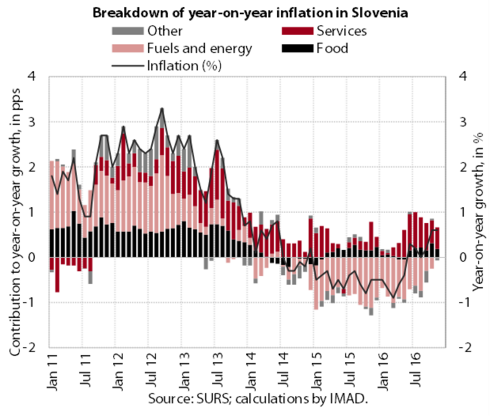
In November, consumer prices remained slightly higher than one year before (0.6%). The level of inflation in the last few months is largely the result of a declining negative contribution of energy prices. After a prolonged period of year-on-year declines, consumer prices in November almost reached the levels recorded at the same period last year. Meanwhile, the prices of services continue to rise year on year, which is mainly attributable to the ongoing recovery in household consumption. Food prices are also higher than a year ago; the prices of durable goods remain lower.
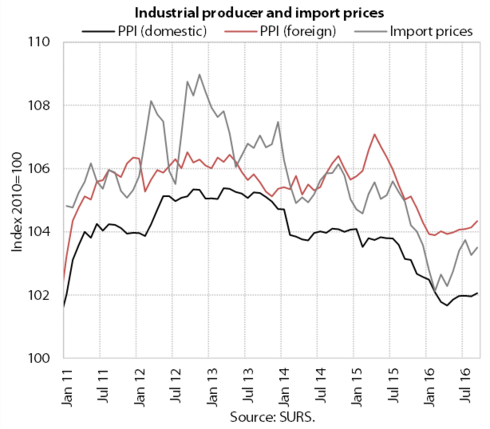
With further price increases for commodities on global markets, import prices rose in October to the level recorded at the end of 2015; the declines in industrial producer prices are also smaller. Domestic producer prices on foreign markets were similar to those for a year earlier, and remained below last year’s levels on the domestic market.
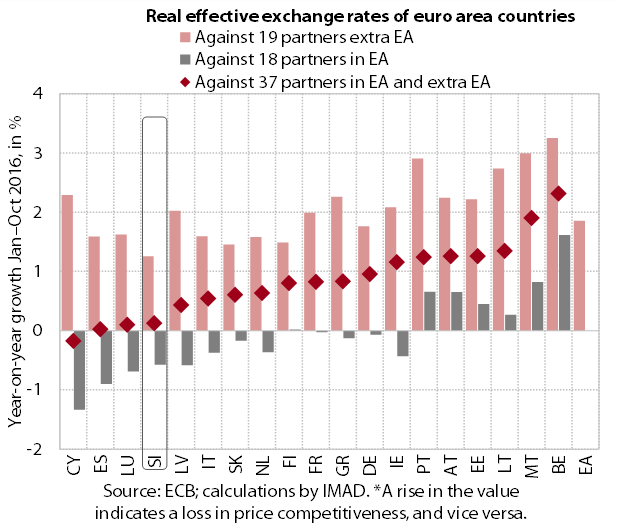
The price competitiveness of Slovenia’s economy remains relatively favourable. The real effective exchange rate deflated by relative consumer prices remains close to last year – the lowest levels since Slovenia’s accession to the EU. The year-on-year decline in relative prices has otherwise been slowing in the past few months, but amid a concomitant slower appreciation of the euro against the currencies of Slovenia’s main trading partners. When compared with other EU Member States for the first ten months of the year, Slovenia recorded slightly larger year-on-year gains in price competitiveness on euro area markets and slightly smaller losses in price competitiveness outside the euro area.
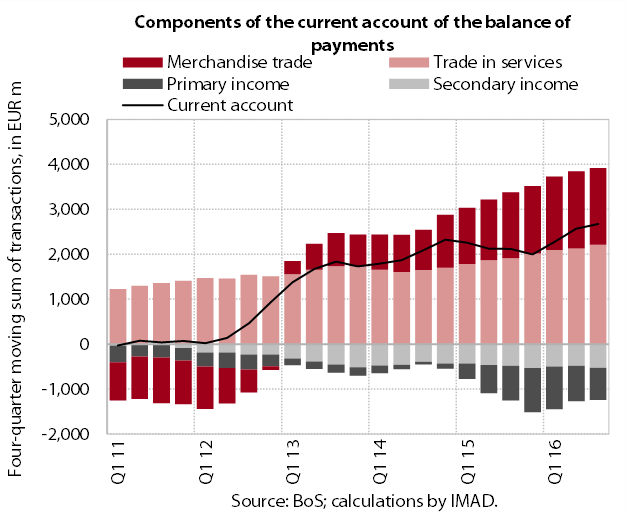
The current account surplus continues to widen. In the third quarter, the surplus mainly stemmed from the higher surplus in services trade; as the terms of trade deteriorated, the surplus in merchandise trade was lower year on year after ten consecutive quarterly rises despite the continuation of favourable export trends. The deficit in primary income remains lower year on year owing to the lower estimates of reinvested earnings of foreign direct investors; the deficit of secondary income is higher as a result of higher general government expenditure. In the twelve months to September, the current account surplus reached 6.7% of GDP.

The net financing of the rest of the world continued. In the third quarter, the net capital outflow of the Bank of Slovenia remained higher than the net capital outflows of the government and private sectors combined. In line with the public sector purchase programme (PSPP), the Bank of Slovenia purchased foreign debt securities in the euro area. It also increased its financial assets abroad and repaid its Eurosystem liabilities. Owing to smaller returns, the government transferred its foreign account deposits to the central bank. In the private sector, net flows of direct investment predominated, particularly in the form of equity of foreign investors.
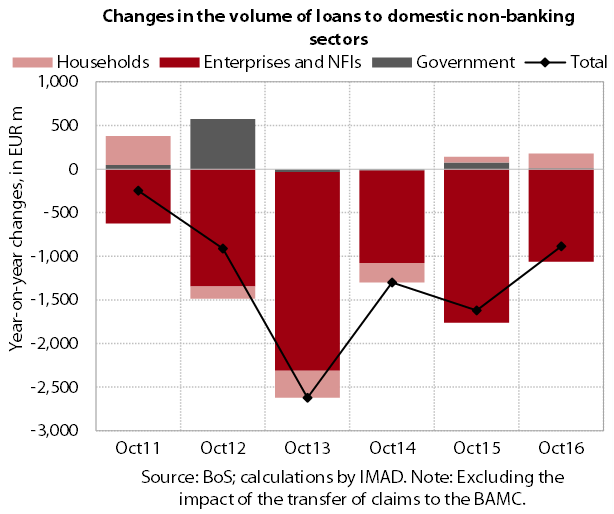
The year-on-year contraction in the volume of loans to domestic non-banking sectors slowed slightly in October in comparison with previous months. This is largely attributable to lower corporate and NFI deleveraging, which is nevertheless still relatively high. In our view, the reason for this lies not only in the banks’ caution in lending, but also weaker corporate demand for bank loans on the domestic market, with enterprises currently having sufficient own resources and other more favourable sources of funding at their disposal. The interest rates for enterprises in the Slovenian banking system are still significantly above the EMU average, and these gaps are widening with longer maturities and the increasing volume of loans. Banks are financing households to a greater extent than enterprises, with households considered less risky clients owing to their lower levels of indebtedness and favourable labour market conditions in general. Interest rates for household loans do not deviate significantly from the EMU average (interest rates for consumer loans are already lower).

The structure of bank liabilities is changing in favour of non-banking sector deposits. These otherwise declined year on year in October, which is a consequence of the base effect and the outflows of government deposits and, to a lesser extent, NFI deposits, while household and corporate deposits continue to rise. It is mainly overnight deposits that are rising, which is deteriorating the maturity structure of sources of finance.
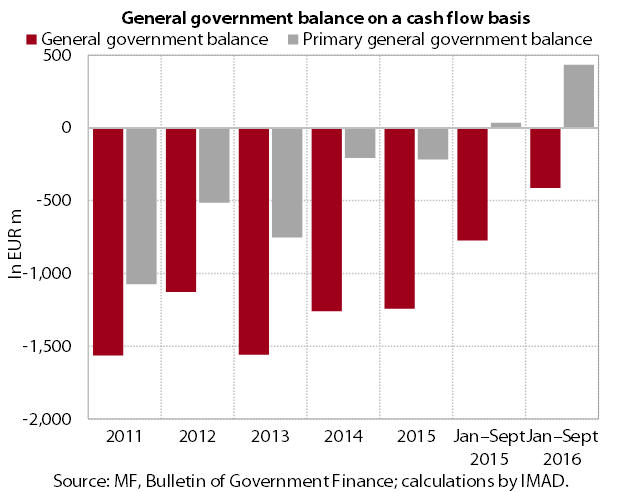
The general government deficit on a cash basis almost halved year on year in the first nine months. This decline mainly reflects better economic conditions, a significant change in the flows of EU funds and the retention of some measures to limit expenditure growth. The positive general government balance, excluding interest expenditure, was also significantly higher than in the same period of 2015.
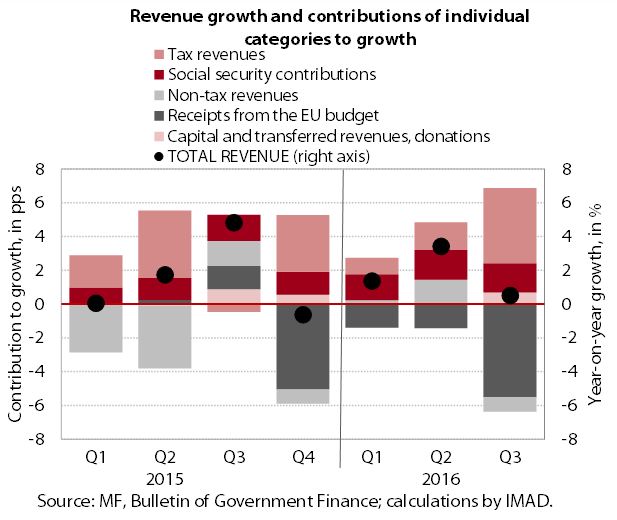
General government revenue rose year on year in the first nine months. The fastest growth is recorded for revenues related to favourable labour market developments. Despite the shift towards a more positive trend, the year-on-year growth of consumption-based revenues remains relatively low this year. This is related not only to the slow recovery in total nominal domestic consumption, but also to transitional factors such as the effect of the change in the payment of VAT on imports.
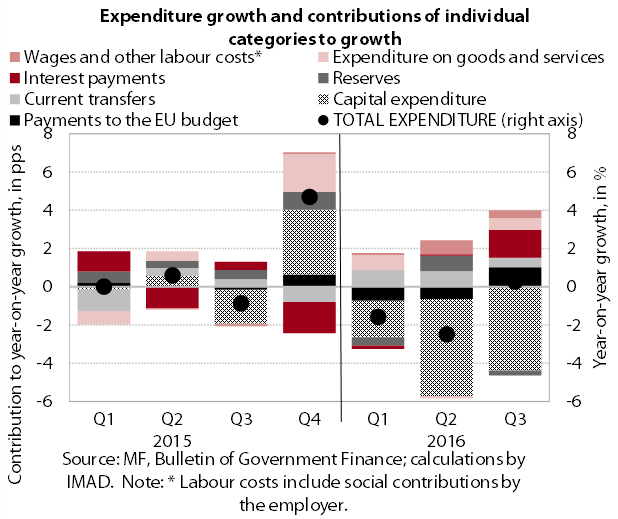
General government expenditure continues to decline year on year. The bulk of this decline stems from lower investment upon the transition to the implementation of the new EU financial perspective. The longer-term trend growth rate in other expenditures otherwise amounts to only slightly more than half the rate of GDP growth, but it has been rising continuously this year, primarily owing to expenditure related to the partial relaxation of austerity measures (the wage bill in the public sector, transfers to individuals and households) and expenditure on goods and services.
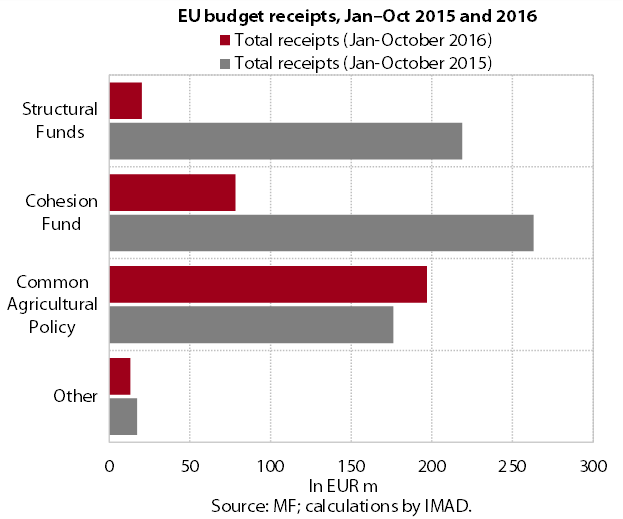
Slovenia’s net budgetary position against the EU budget was negative in the first ten months. EU budget receipts totalled EUR 333.1 million, and payments to the EU budget amounted to EUR 7 million more. The bulk of receipts were funds for the implementation of the Common Agricultural and Fisheries Policy (EUR 197.0 million: 63.0% of the funds envisaged in the budget). The majority of the resources from the Cohesion Fund and Structural Funds that were paid into the state budget in the first five months of the year were from the previous financial perspective. Under the new financial perspective, only EUR 20 million was disbursed from the state budget for projects.

